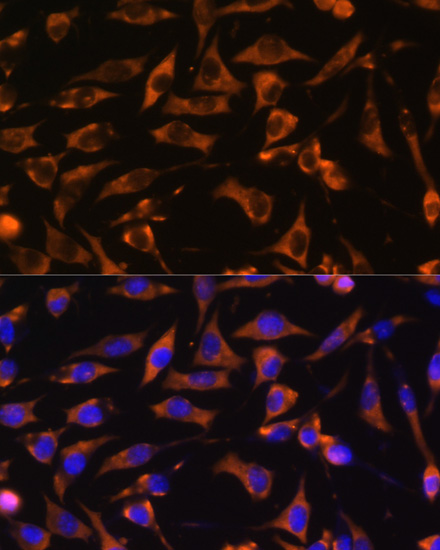Cell Biology Antibodies 13
Anti-KANK1 Antibody (CAB17106)
- SKU:
- CAB17106
- Product Type:
- Antibody
- Reactivity:
- Human
- Reactivity:
- Mouse
- Host Species:
- Rabbit
- Isotype:
- IgG
- Antibody Type:
- Polyclonal Antibody
- Research Area:
- Cell Biology
Description
| Antibody Name: | Anti-KANK1 Antibody |
| Antibody SKU: | CAB17106 |
| Antibody Size: | 20uL, 50uL, 100uL |
| Application: | WB IF |
| Reactivity: | Human, Mouse |
| Host Species: | Rabbit |
| Immunogen: | A synthetic peptide corresponding to a sequence within amino acids 900-1000 of human KANK1 (NP_055973.2). |
| Application: | WB IF |
| Recommended Dilution: | WB 1:500 - 1:2000 IF 1:50 - 1:200 |
| Reactivity: | Human, Mouse |
| Positive Samples: |
| Immunogen: | A synthetic peptide corresponding to a sequence within amino acids 900-1000 of human KANK1 (NP_055973.2). |
| Purification Method: | Affinity purification |
| Storage Buffer: | Store at -20°C. Avoid freeze / thaw cycles. Buffer: PBS with 0.02% sodium azide, 50% glycerol, pH7.3. |
| Isotype: | IgG |
| Sequence: | GNYL GYTC KCGG LQSG SPLS SQTS QPEQ EVGT SEGK PISS LDAF PTQE GTLS PVNL TDDQ IAAG LYAC TNNE STLK SIMK KKDG NKDS NGAK KNLQ FVGI N |
| Gene ID: | 23189 |
| Uniprot: | Q14678 |
| Cellular Location: | |
| Calculated MW: | 129kDa/147kDa |
| Observed MW: | Refer to figures |
| Synonyms: | KANK1, ANKRD15, CPSQ2, KANK |
| Background: | The protein encoded by this gene belongs to the Kank family of proteins, which contain multiple ankyrin repeat domains. This family member functions in cytoskeleton formation by regulating actin polymerization. This gene is a candidate tumor suppressor for renal cell carcinoma. Mutations in this gene cause cerebral palsy spastic quadriplegic type 2, a central nervous system development disorder. A t(5;9) translocation results in fusion of the platelet-derived growth factor receptor beta gene (PDGFRB) on chromosome 5 with this gene in a myeloproliferative neoplasm featuring severe thrombocythemia. Alternative splicing of this gene results in multiple transcript variants. A related pseudogene has been identified on chromosome 20. |
| UniProt Protein Function: | ANKRD15: Involved in the control of cytoskeleton formation by regulating actin polymerization. Inhibits actin fiber formation and cell migration. Inhibits RhoA activity; the function involves phosphorylation through PI3K/Akt signaling and may depend on the competetive interaction with 14-3-3 adapter proteins to sequester them from active complexes. Inhibits the formation of lamellipodia but not of filopodia; the function may depend on the competetive interaction with BAIAP2 to block its association with activated RAC1. Inhibits fibronectin-mediated cell spreading; the function is partially mediated by BAIAP2. Inhibits neurite outgrowth. Involved in the establishment and persistence of cell polarity during directed cell movement in wound healing. In the nucleus, is involved in beta-catenin-dependent activation of transcription. Potential tumor suppressor for renal cell carcinoma. Defects in KANK1 are the cause of cerebral palsy spastic quadriplegic type 2 (CPSQ2). A non-progressive disorder of movement and/or posture resulting from defects in the developing central nervous system. Affected individuals manifest congenital hypotonia evolving over the first year to spastic quadriplegia with accompanying transient nystagmus and varying degrees of mental retardation. Neuroimaging shows brain atrophy and ventriculomegaly. 2 isoforms of the human protein are produced by alternative promoter. |
| UniProt Protein Details: | Protein type:Tumor suppressor Chromosomal Location of Human Ortholog: 9p24.3 Cellular Component: cytoplasm; nucleus Molecular Function:protein binding; beta-catenin binding Biological Process: negative regulation of Rho protein signal transduction; transcription, DNA-dependent; regulation of transcription, DNA-dependent; negative regulation of actin filament polymerization; negative regulation of insulin receptor signaling pathway; positive regulation of Wnt receptor signaling pathway; negative regulation of cell migration Disease: Cerebral Palsy, Spastic Quadriplegic, 2 |
| NCBI Summary: | The protein encoded by this gene belongs to the Kank family of proteins, which contain multiple ankyrin repeat domains. This family member functions in cytoskeleton formation by regulating actin polymerization. This gene is a candidate tumor suppressor for renal cell carcinoma. Mutations in this gene cause cerebral palsy spastic quadriplegic type 2, a central nervous system development disorder. A t(5;9) translocation results in fusion of the platelet-derived growth factor receptor beta gene (PDGFRB) on chromosome 5 with this gene in a myeloproliferative neoplasm featuring severe thrombocythemia. Alternative splicing of this gene results in multiple transcript variants. A related pseudogene has been identified on chromosome 20. [provided by RefSeq, Dec 2014] |
| UniProt Code: | Q14678 |
| NCBI GenInfo Identifier: | 379056374 |
| NCBI Gene ID: | 23189 |
| NCBI Accession: | NP_001243805.1 |
| UniProt Related Accession: | Q14678 |
| Molecular Weight: | 36kDa |
| NCBI Full Name: | KN motif and ankyrin repeat domain-containing protein 1 isoform L |
| NCBI Synonym Full Names: | KN motif and ankyrin repeat domains 1 |
| NCBI Official Symbol: | KANK1 |
| NCBI Official Synonym Symbols: | KANK; CPSQ2; ANKRD15 |
| NCBI Protein Information: | KN motif and ankyrin repeat domain-containing protein 1 |
| UniProt Protein Name: | KN motif and ankyrin repeat domain-containing protein 1 |
| UniProt Synonym Protein Names: | Ankyrin repeat domain-containing protein 15; Kidney ankyrin repeat-containing protein |
| Protein Family: | KN motif and ankyrin repeat domain-containing protein |
| UniProt Gene Name: | KANK1 |
| UniProt Entry Name: | KANK1_HUMAN |







